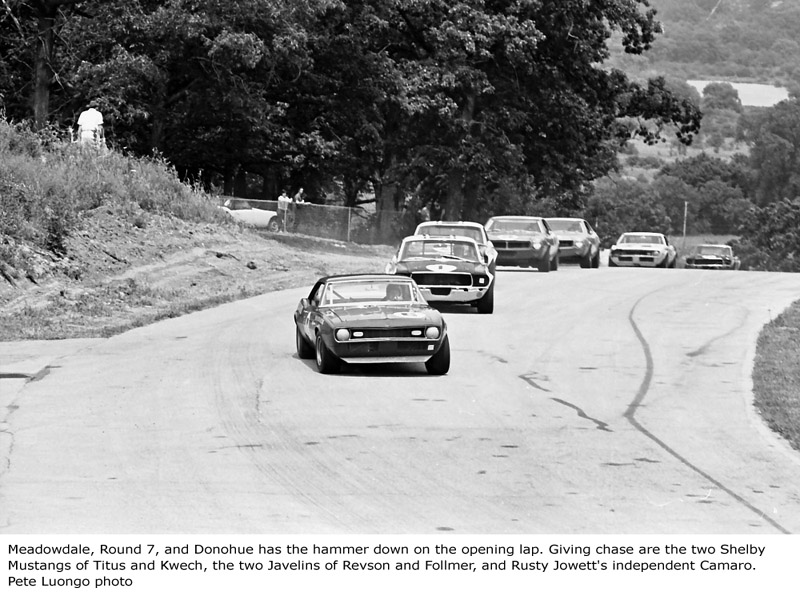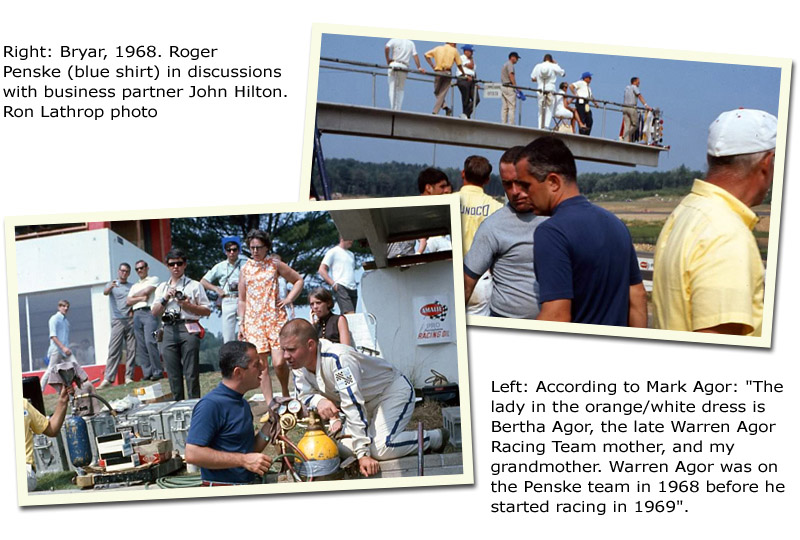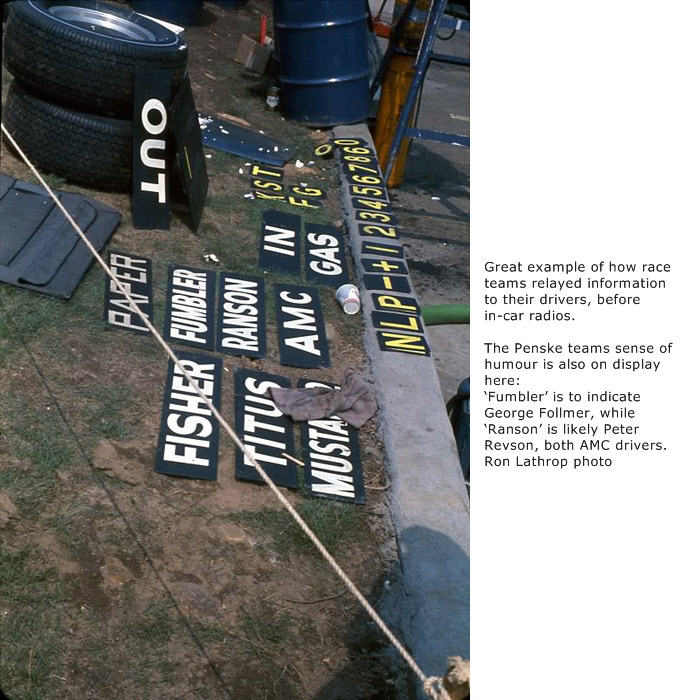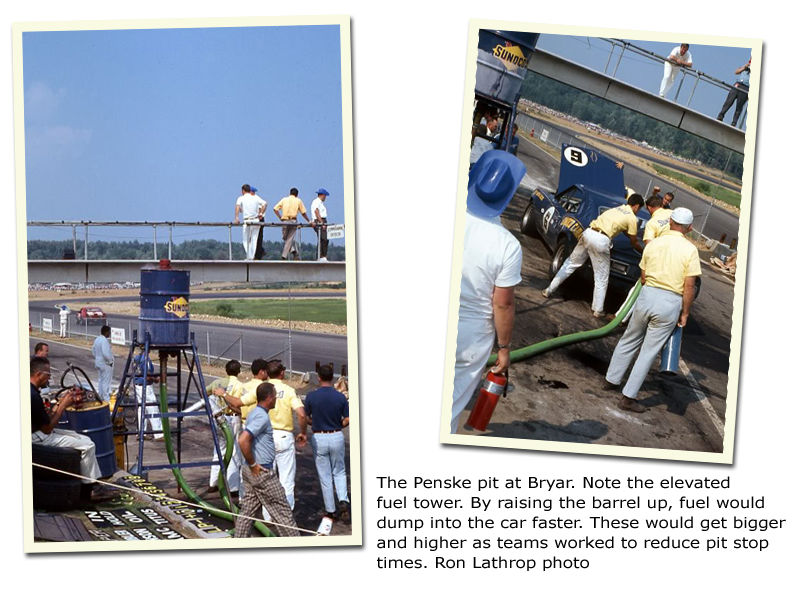-
Administrator


Prior to Bryar, Donohue rightly concluded that a roll cage could serve a greater purpose than simply protecting the driver’s head if the car was ever tipped on its lid. In 1967, most Trans-Am cars were fitted with a simple roll-hoop that ran the width of the car and attached to the floor at four points rearward of the driver. Donohue figured he could use the roll cage to aid chassis rigidity, as was common practice in stock car racing, whereby the cage tubes would connect all four corners of the car. The cage was constructed using steel tubing 1.5 inches in diameter, and .060 inch thick. This action prevented the car from flopping and twisting, and it responded better to chassis set-up changes. Later Penske cars would utilise thinner .040 wall tubing when the Camaro went down the side of a cliff on its way to a race. While the body suffered damage, the beefy cage was unscathed.
Just a single week separated the Bryar race on August 8, and the next round at Marlboro Park Raceway, on August 13, but in that week, great strides were taken. Chevrolet engineer Jim Musser ordered several sets of front and rear springs, and the team arrived early at Marlboro for testing. Vince Piggins had produced new, stronger axles (sadly, about a week too late), and the new springs were tried. Donohue explains: “We started jacking around with all those different springs – and the minute I drove it with the soft springs, I knew everything was going to be alright”. When the Camaro was first built, Donohue settled on spring rates of 1,200 and 400 pounds, front to rear. Testing at Marlboro revealed an optimum 550 front, 180 rear set-up that was less than half what they started out with.

While at Marlboro, they also worked at getting more negative camber into the front wheels (where the tops of the front wheels are closer together than the bottoms, to improve weight transfer and grip levels through cornering), so the outside tire would stand upright through cornering, rather than lay over on its outer edge. Four degrees of negative camber was found to be the optimum, which made steering impossibly heavy, but cornering was vastly improved. Additionally, the rear radius rod was binned, which helped deal with the rear axle hop problem, while Musser produced a rear anti-roll bar, to rid the car of understeer.
The Marlboro round was contested over 300 miles, with each car having two drivers. Donohue teamed up with Craig Fisher. The pair stuck the Camaro on pole, and Penske’s team won their first Trans-Am race, by a full two laps.
Using all the tricks learned to date, an all-new Camaro was constructed to contest the final races in 1967. This was the first car to be acid-dipped, and the team dipped like crazy. So much so, this Camaro would commonly be referred to as the ‘lightweight car’, for obvious reasons. Following the Marlboro win, two more Trans-Am victories were recorded late in 1967, and the Penske team strode off into the off-season with momentum on their side.

For 1968, two all-new Camaros were constructed, using all the knowledge and experience gained during the turbulent 1967 season. Both cars would be cleaner, stronger, faster, more purposeful from the outset, and built for ease of maintenance. The team started not with road cars, as they had done with the first ‘67 car, but with ‘bodies in white’. These were special-order body shells which had been plucked from the Chevrolet assembly line prior to being laden with heavy sound deadener. Sound deadener is fitted to road cars to help muffle out road noise, but in race cars it provides nothing but dead weight. In addition to the two bodies in white that would become race cars, there were between one and three additional bodies supplied to Penske. The bodies and several associated parts were then acid-dipped.
The new cars were blasted in a fresh coat of bright blue paint for sponsor Sunoco. ‘Sunoco Camaro’ was emblazoned along the rear fenders in bold yellow lettering. The cars were works of art. Pin-striping was prevalent throughout, and featured on the hood, the tail pan, and along the hip-line, further enhancing the Camaros curvaceous shape. Large white ‘roundals’ with black borders were applied to the doors and hood. Front chin spoilers wore a contrasting yellow in early rounds, switching to red in later rounds.

Beneath the skin, the Penske machines were just as beautiful. A rigid roll cage connected all four corners of the car. Anything that didn’t serve a purpose was removed. Interiors were sparse, and business-like, with only a race seat, gear shifter, dash, and doors cards contrasting with the clean light-grey paint that filled the cabin. Beneath the hood nestled a Traco built 302 cu.in Chevy, backed by a 4-speed Muncie M22 ‘rockcrusher’, and GM 12-bolt rear-end with limited slip diff. Koni shocks provided the suspending. Brakes were 11.75 inch Corvette discs, while wheels were 15 x 8 inch magnesium American Racing. Partway through the 1967 season, Penske picked up a tire deal, switching from Firestone to Goodyear. It wasn’t just the auto makers and race teams who were at war, Goodyear and Firestone were also engrossed in a battle to produce the best racing tire. Tires were rapidly increasing in grip, durability, and size, and to house the latest king-sized racing boots, the ’68 Penske Camaros featured subtle fender flaring, and custom made wheel tubs in the rear, similar to modern mini-tubs in many road and race cars. Bumpers were removed, as allowed under the rules, to further reduce weight.
 Posting Permissions
Posting Permissions
- You may not post new threads
- You may not post replies
- You may not post attachments
- You may not edit your posts
-
Forum Rules






 Reply With Quote
Reply With Quote